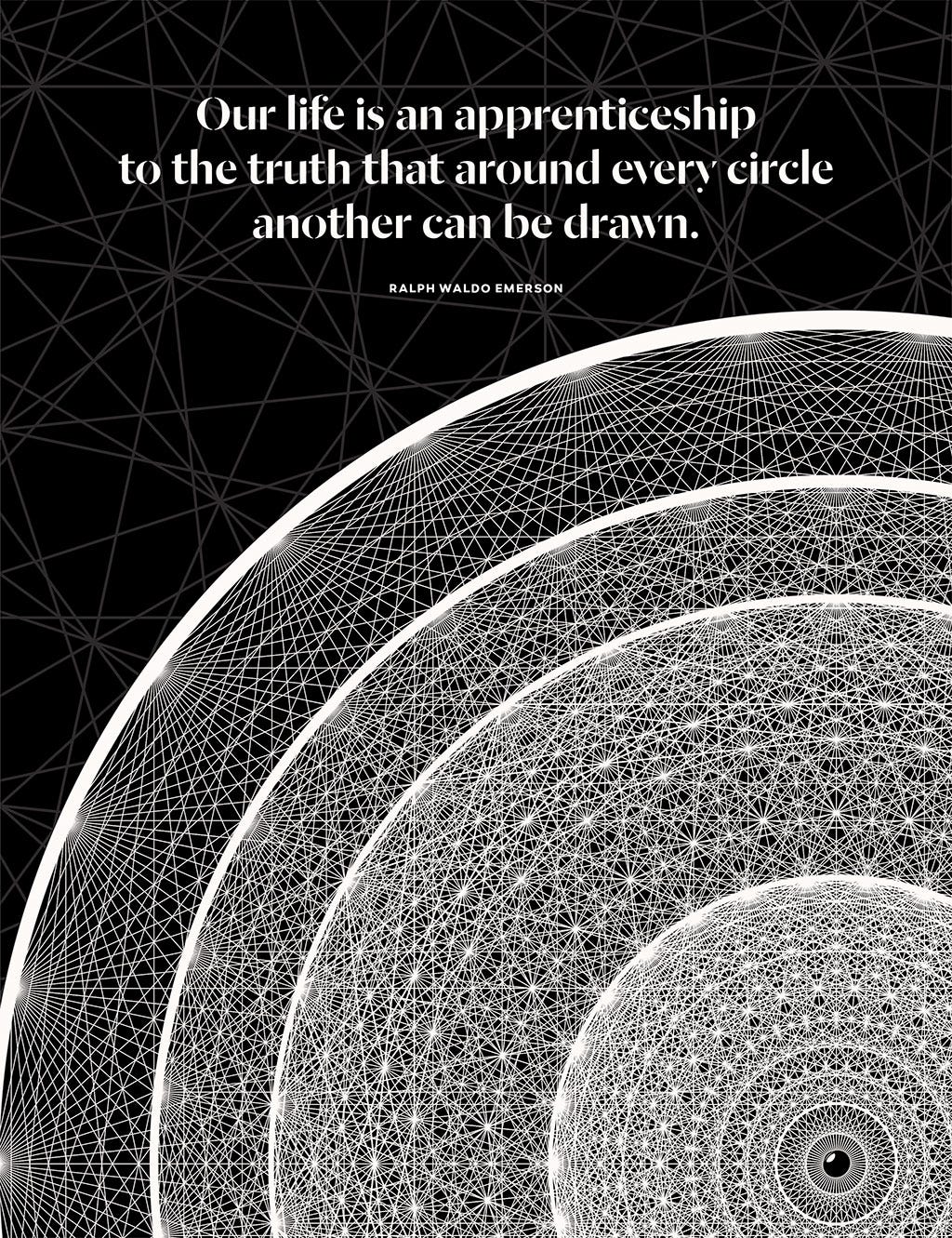
Emerson on The Limits of Knowledge
"The eye is the first circle; the horizon which it forms is the second; and throughout nature this primary figure is repeated without end…. Our life is an apprenticeship to the truth, that around every circle another can be drawn; that there is no end in nature, but every end is a beginning; that there is always another dawn risen on mid-noon, and under every deep a lower deep opens.” - Ralph Waldo Emerson, Circles
What an extraordinary metaphor Emerson gave us in this essay. It immediately set my imagination to work visualizing human how each individual’s understanding of the world overlaps with every other person’s understanding.
A Mental Model
Imagine all human beings as singular bright points on a map, exploring a vast, black empty space. As each of us must learn about the world, we trace a line across the intellectual territory we master, following the threads left for us by others. And where we discover truths about the world, we light up the map.
The First Circle
Where did we humans start? In ignorance, in the middle of a vast, empty space. I’d imagine that hunter-gatherers’ understanding of the world around them did not stretch very far out: they knew nothing of other, flora or fauna on other continents, let alone germ theory or quantum mechanics. But what they did know, they needed to know, and their understanding was comprehensive and well distributed among them. Each of them was richly informed about their local habitat, far more than we are today. The seasons, the behavior of animals, the properties of plants, and the patterns of the stars, all of their knowledge was holistic, interconnected, and vital, and the world view it espoused would have been shared by all of them, binding them together. Picture those points of light traveling in tightly wound, predictable and well-lit paths, steadily dancing in harmony with each other across centuries.
As humanity evolved, we transitioned from a nomadic lifestyle to an agricultural one, expanding our sphere of understanding outward from that tight circle. Agriculture made us sedentary, and allowed for the specialization of labor, some individuals farming, others fishing, blacksmithing, breeding livestock, etc. And eventually, reliance on particular patches of land also lead to the specialization of defending that land from others, and the codification in government of roles, hierarchies, knowledge itself. Imagine those points of light beginning to stretch out in wider orbits, still returning to a communal center, but reaching out farther and farther as we discovered more about these specific domains of knowledge and brought our discoveries back to the village.
Accelerating Orbits
The Industrial Revolution accelerated this trend with machinery and mass production, creating even more specialized roles. For those who moved into urban zones, specialization became necessary. Fundamental discoveries like steam engines, trains, chemistry and machining opened the doors for tremendous expansion of knowledge, and those who pushed right out to the edges were rewarded handsomely. The points of light stretch farther and in tighter arcs than ever, and in some cases, never explore or share the light of much of the rest of our knowledge map. For the first time, alienation and nihilism become a broad topic of art and philosophy. Even as the map is expanding, the moving points are fragmenting into isolated territories.
The Information Age brought unprecedented access to knowledge and an inevitable hyper-specialization, with experts in incredibly niche fields racing to illuminate new areas of understanding, while knowing less and less about even the most adjacent fields of inquiry, let alone unrelated ones. Notably, by now most people never approach the edges of the map, and many don’t travel much in other territories beyond their own narrow niche. This may be due in part to a lack of ability or interest, but it is almost universally restricted by a lack of time. We simply can’t know all the things anymore.
Terminal Velocity
At least the Social Media Age allows us to reconnect with all of the other isolated points in our little corner of the map. Perhaps it alleviates some of the feeling of isolation and alienation that the fragmentation of experience caused. But these connections are usually fleeting and shallow, often centered around some hobby or consumer interest. In some ways, it leads to a shrinking of our orbits. In the realm of national identity and politics, these shrinking, isolated clusters of orbits can become violently disjointed, as we grow wary and distrustful of each other and of hallowed institutions. And in all cases, it flows toward isolation. How can we share our knowledge when we don’t even share reality anymore?…where every individual (or tribe of individuals) can confirm whatever reality they like one swipe at a time? If we continue down this path, perhaps with personal AI assistants leading the charge, each of us in our own personal artificial reality, we will drift farther away from one another. As the map expands, we will drift toward a kind of reality heat-death where each point of light is hopelessly isolated from every other one.
I suppose this all amounts to an appeal for generalists, for a re-connection with nature, and above all with each other in real life. Emerson's concept of "circles" reflects the possibilities and challenges of the continuous expansion of our understanding of the universe. Each circle represents a new possibility for enlightenment. But even as we draw new circles, we can’t forget the importance of the connections between them and between each other. Only then can we truly gain knowledge without losing ourselves in the process.
About the Art
“This illustration takes inspiration from a geometric shape at the edge of humankind’s mathematical horizon, the E8 lattice. ‘E8’ is an interrelated 248-dimensional symmetrical object that has been described by some physicists as ‘the key to the theory of everything.’”
Art by Evan Robertson. All rights reserved.


